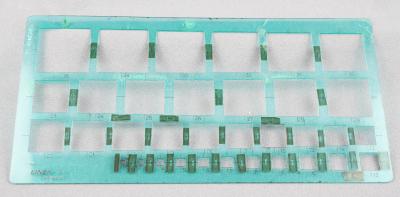SLIDE RULE MATHEMATICAL CALCULATOR SLIDE RULE
The slide rule has 3 parts. The centre piece that slides for calculating measuements and the remaining 2 outer parts. On each side of the rule are figures for calculating measurements. Each end is metal to hold the rule together. The rule also has a plastic face which slide up and down and has a line to calculate the correct measurement. This face has 2 cracks in the plastic. Text on the rule is [STADIA/VERSINES/ .1 25'50'31/.01 8' 06' 35'/.001 2' 33' 45'/.000 48' 37' .0001 15' 23'/DUALFACE TRIGONOMETRICAL/SLIDE RULE. MODEL 476/MELBOURNE >W&G< AUSTRALIA/PAT APP.NO13643/47/COPYRIGHT/]. On each part of the slide are the words Standia on top, Sin in middle, and Tan on bottom. On the reverse side of the rule tope is LL, middle slide Reciprocal, and bottom Cu. The face is plastic, not cracked, and has 4 screws in each corner. There are several measurement written on the slide on both sides. At the right end are COS/ RADIANS 1 57' 17' 45'/.1 4' 43' 46'/.01 34' 23'/ .001 3' 26' .0001 20-6'/COT.
This drawing tool was used by Jurgen Gossman in the 1980s and 1990s when he was a town planner and later a member of the planning department in the City of Armadale. These tools were used to create hand drawn technical plans for subdivisions, drainage systems, roads and other engineering tasks. In the mid to late 1990s the need to use these tools was slowly replaced by computer programs. Staff would have been trained in how to use these tools as they were gaining their engineering degrees.
This slide rule is part of a collection of calculating instruments. It is the primary instrument for calculation in professions such as engineering and surveying and was invented in the 17th century by William Oughtred of Cambridge. However, it was not until around 1850 that the slide rule became more commonplace. Since then, the slide rule has taken many forms. This object was made in Australia by W&G. The company was formed during the 1930s to make gramaphone records but during the Second World War, they started making slide rules. As with many manual implements used in trade, the importance of the slide rule began to diminish when digital electronic calculators became the norm.
Since the establishment of local governments across Western Australian in 1871, they have been responsible for the designing and construction of local roads and drains. They also quickly became responsible for town planning, meaning staff with the skills to create accurate drawings have always been needed. The tool represents a manual skill that was essential for council staff who worked in the planning department that has now been replaced by computer programs.
Details
Details
[STADIA/VERSINES/ .1 25'50'31/.01 8' 06' 35'/.001 2' 33' 45'/.000 48' 37' .0001 15' 23'/DUALFACE TRIGONOMETRICAL/SLIDE RULE . MODEL 476/MELBOURNE >W&G< AUSTRALIA/PAT APP.NO13643/47/COPYRIGHT]
This object is part of a collection of technical drawing tools that were used to create highly accurate and detailed hand drawn technical plans. These tools have now been replaced with computer programs and the skills required to use this collection is slowly being lost.
City of Armadale - History House
City of Armadale - History House
More items like this
Other items from City of Armadale - History House
- SET ANGLE & DISTANCE TEMPLATE
- SQUARE DRAWING TEMPLATE
- FIXED CURVE PLASTIC TEMPLATE BOX WITH DRAWING CURVES
- FIXED CURVE PLASTIC TEMPLATE BOX WITH DRAWING CURVES
- FIXED CURVE PLASTIC TEMPLATE BOX WITH DRAWING CURVES
- FIXED CURVE PLASTIC TEMPLATE BOX WITH DRAWING CURVES
- FIXED CURVE PLASTIC TEMPLATE BOX WITH DRAWING CURVES
- FIXED CURVE PLASTIC TEMPLATE BOX WITH DRAWING CURVES
- FIXED CURVE PLASTIC TEMPLATE BOX WITH DRAWING CURVES
- FIXED CURVE PLASTIC TEMPLATE BOX WITH DRAWING CURVE
- CARRY CASE FOR PLASTIC CURVE TEMPLATES
- PARALLEL DRAWING ROLLER


